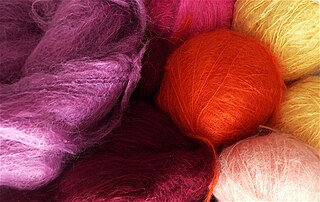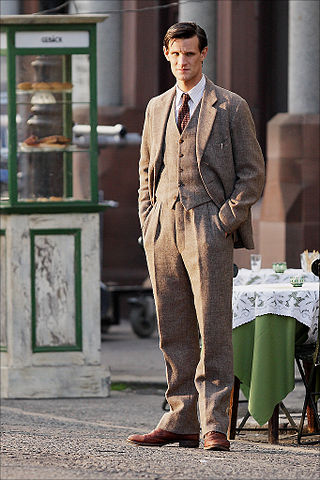Related Research Articles

Mohair is a fabric or yarn made from the hair of the Angora goat. Both durable and resilient, mohair is lustrous with high sheen, and is often blended to add these qualities to a textile. Mohair takes dye exceptionally well. It feels warm in winter due to excellent insulating properties, while moisture-wicking keeps it cool in summer. It is durable, naturally elastic, flame-resistant and crease-resistant. It is considered a luxury fiber, like cashmere, angora, and silk, but is more expensive than most sheep's wool.

A suit, lounge suit, or business suit is a set of clothes comprising a suit jacket and trousers of identical textiles generally worn with a collared dress shirt, necktie, and dress shoes. A skirt suit is similar, but with a matching skirt instead of trousers. It is currently considered semi-formal wear or business wear in contemporary Western dress codes, however when the suit was originally developed it was considered an informal or more casual option compared to the prevailing clothing standards of aristocrats and businessmen. The lounge suit originated in 19th-century Britain as sportswear and British country clothing, which is why it was seen as more casual than citywear at that time, with the roots of the suit coming from early modern Western Europe formal court or military clothes. After replacing the black frock coat in the early 20th century as regular daywear, a sober one-coloured suit became known as a lounge suit.

Angora hair or Angora fibre refers to the downy coat produced by the Angora rabbit. While the names of the source animals are similar, Angora fibre is distinct from mohair, which comes from the Angora goat. Angora fibre is also distinct from cashmere, which comes from the cashmere goat. Angora is known for its softness, thin fibres, and what knitters refer to as a halo (fluffiness). It is also known for its silky texture. It is much warmer and lighter than wool due to the hollow core of the angora fibre. It also gives the wool its characteristic floating feel.

Cashmere wool, usually simply known as cashmere, is a fiber obtained from cashmere goats, pashmina goats, and some other breeds of goat. It has been used to make yarn, textiles and clothing for hundreds of years. Cashmere is closely associated with the Kashmir shawl, the word "cashmere" deriving from an anglicization of Kashmir, when the Kashmir shawl reached Europe in the 19th century. Both the soft undercoat and the guard hairs may be used; the softer hair is reserved for textiles, while the coarse guard hair is used for brushes and other non-apparel purposes. Cashmere is a hygroscopic fiber which essentially means that it absorbs water from the air. This helps regulate the body in both warm and cool temperatures by absorbing and releasing moisture based on the surrounding environment.

Pashmina refers to, depending on the source, the cashmere wool of the Changthangi cashmere goat, for fine Kashmiri cashmere wool or a synonym for cashmere wool.
Ermenegildo Zegna N.V., also known as Zegna or the Ermenegildo Zegna Group, is an Italian luxury fashion house. It was founded in 1910 by Ermenegildo Zegna in Trivero, Biella, in the Piedmont region of northern Italy. As of 2021, it is a public company that is listed on the New York Stock Exchange.

Harris tweed is a tweed cloth that is handwoven by islanders at their homes in the Outer Hebrides of Scotland, finished in the Outer Hebrides, and made from pure virgin wool dyed and spun in the Outer Hebrides. This definition, quality standards and protection of the Harris tweed name are enshrined in the Harris Tweed Act 1993.

Camel hair specifically refers to the fur from the body of a camel, but more generally refers to the fibre that may be made from either pure camel hair or a blend of camel hair and another fibre.
Cerruti 1881, also known as Cerruti, is an Italian luxury fashion house founded in 1967 and headquartered in Paris. It was founded by the Italian stylist and fashion producer Nino Cerruti. It was named "1881" because Nino's grandfather established the family woolen mill, Fratelli Cerruti Wool Mill, in Italy in 1881.
Loro Piana is an Italian company specialising in clothing and textile products, claiming to be the world's largest cashmere manufacturer. It was founded in 1924 and is owned by French multinational holding and conglomerate LVMH.

Informal wear or undress, also called business wear, corporate/office wear, tenue de ville or dress clothes, is a Western dress code for clothing defined by a business suit for men, and cocktail dress or pant suit for women. On the scale of formality, it is considered less formal than semi-formal wear but more formal than casual wear. Informal or undress should not be confused with casual wear such as business casual or smart casual; most situations calling for “informal wear” will usually tolerate casual dress to varying extents.
Chiengora, also called "dog wool," is yarn or wool spun from dog hair. The word is a portmanteau of chien and angora and was coined by an American spinner, Annette Klick. Dog hair is up to 80% warmer than wool and is not elastic.

Moxon Huddersfield Ltd is a high-end British textile manufacturer of luxury worsted and woollen suiting fabrics. It is located at Yew Tree Mills, Holmbridge, near Holmfirth, Kirklees in Yorkshire.

Herringbone, also called broken twill weave, describes a distinctive V-shaped weaving pattern usually found in twill fabric. It is distinguished from a plain chevron by the break at reversal, which makes it resemble a broken zigzag. The pattern is called herringbone because it resembles the skeleton of a herring fish. Herringbone-patterned fabric is usually wool, and is one of the most popular cloths used for suits and outerwear. Tweed cloth is often woven with a herringbone pattern.
An S number on the label of wool suits or other tailored apparel, wool fabric, or yarn, indicates the fineness of the wool fiber used in the making of the apparel, as measured by its maximum diameter in micrometres. Fiber fineness is one of the factors determining the quality and performance of a wool product. In recent years it has also become an important marketing device used by many mills, garment makers, and retailers. The S number appears as a plural with an s or 's following the number, such as 100s or 100's.
Satinet is a finely woven fabric with a finish resembling satin, but made partly or wholly from cotton or synthetic fiber. The fibers may be natural or synthetic.

Luciano Barbera is a high-end men’s clothing company based in Biella, Italy, a town and commune in the northern Italian region of Piedmont.

Vitale Barberis Canonico (VBC) is an Italian fabric mill that was established in 1663. It is located in Pratrivero, about 50 miles northeast of Turin in the Piedmont region of northwest Italy.
Siyaram Silk Mills Limited, also known as Siyaram's and as SSML, is an Indian blended fabric and garment-manufacturer, with an associated chain of retail outlets and branded showrooms and an online store—Siyaram's Online Shop. Siyaram's was incorporated in 1978, and is headquartered in the Kamala Mills compound, Lower Parel, Mumbai.
Fratelli Piacenza S.p.A. is an Italian fabric mill and family business established in 1733. Fratelli Piacenza has been accepted as a member house in the Henokiens, an association of companies that have been continuously operating and remain family-owned for 200 years or more.
References
- ↑ ethomas.com History
- ↑ ethomas.com Fabrics
- ↑ E. Thomas superfine menswear fabrics Autumn/Winter 2015/2016 7 October 2014
- ↑ Club Monaco's Aaron Levine on Men's Fashion The Wall Street Journal September 5, 2014
- ↑ hickeyfreeman.com Wool cashmere blend grey minicheck jacket Archived 2022-04-28 at the Wayback Machine